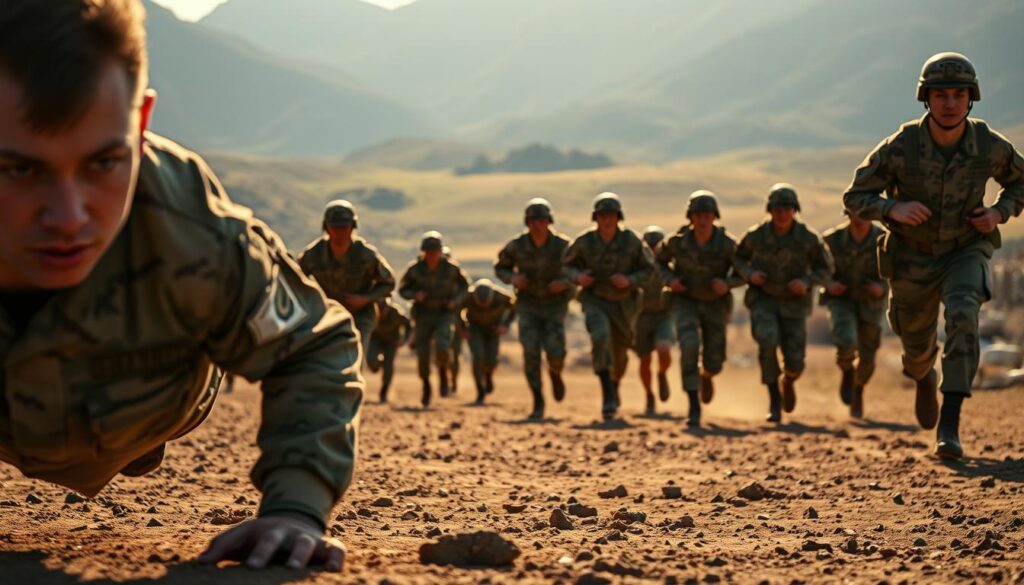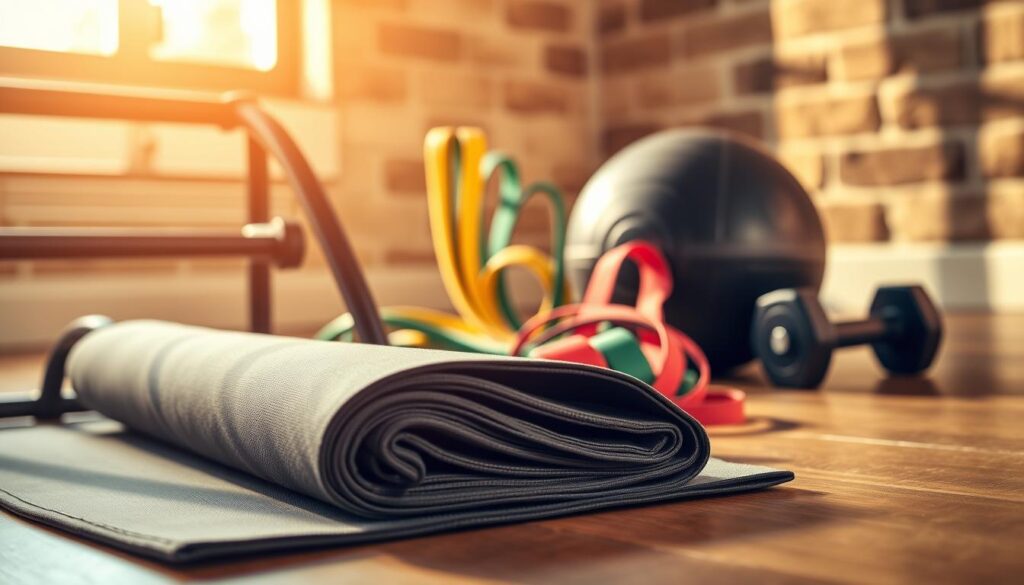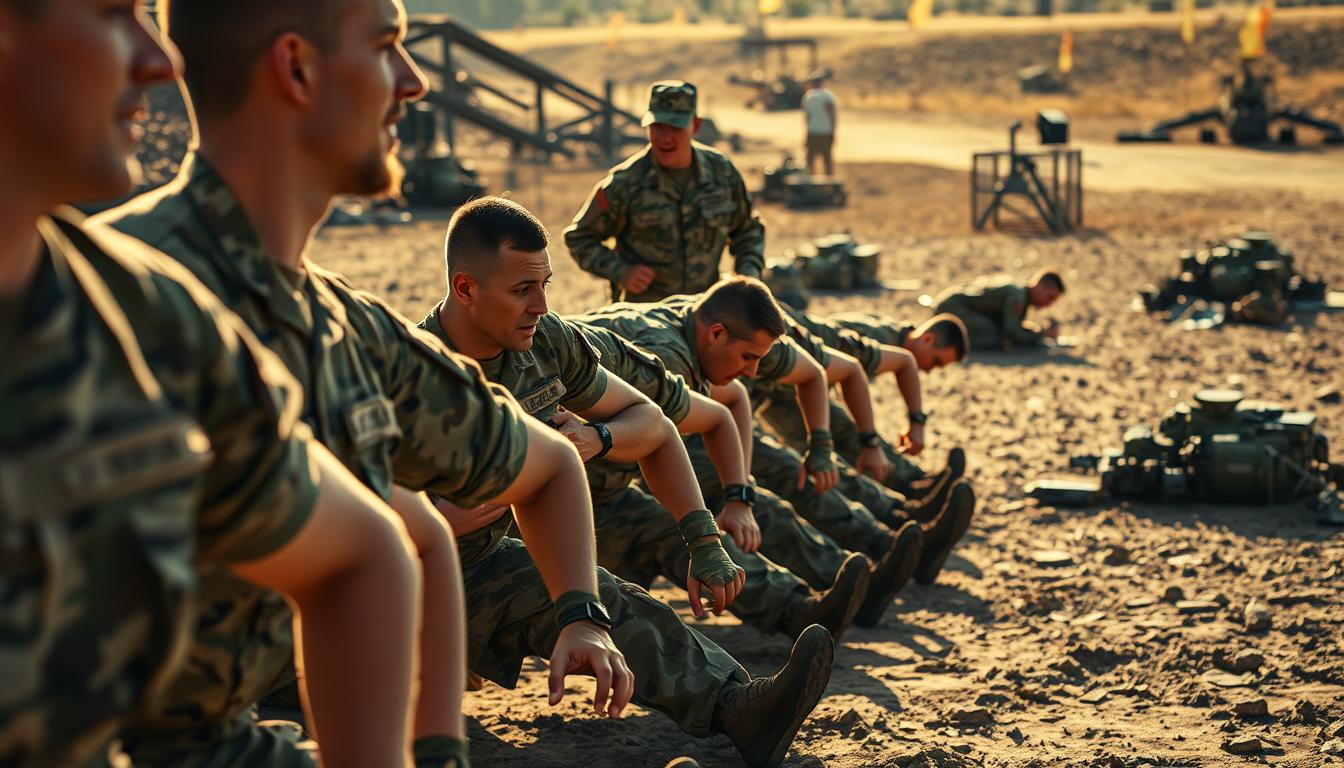Can a tough training program unlock a Soldier’s full potential? Effective military fitness is key for Soldiers to do their jobs well. It boosts strength, stamina, agility, and coordination. It also raises morale and builds self-confidence.
The Army PRT program gets Soldiers ready for military life. It focuses on functional fitness to better performance and lower injury risk.
Key Takeaways
- Army PRT enhances Soldier performance and overall well-being.
- Military fitness is crucial for effective duty performance.
- The program focuses on functional fitness to improve readiness.
- Proper conditioning boosts morale and self-confidence.
- Army PRT aims to reduce the risk of injury.
Understanding the Importance of Physical Readiness
The Army places a huge emphasis on physical readiness. It’s key for Soldier success and health. A solid physical fitness program is essential to prepare Soldiers for military duties.
Physical training is more than just meeting Army fitness standards. It builds a fitness culture that boosts overall health. This training improves health, resilience, and performance in various tasks.
Benefits of Army Physical Readiness Training
The Army physical training program boosts heart health, muscle strength, and flexibility. These improvements help Soldiers perform better in tough situations.
Also, a good fitness program lowers injury risks, improves mental health, and boosts life quality. The Army aims to create a culture that values fitness and well-being through physical readiness.

Connection to Soldier Effectiveness
Physical readiness directly links to Soldier effectiveness. Fit Soldiers can do their jobs better, handle tough situations, and recover from injuries.
Physical training also builds mental resilience, crucial for Soldiers in stressful environments. It enhances both physical and mental abilities, preparing Soldiers for military life demands.
Impact on Health and Well-Being
Physical readiness training greatly benefits health and well-being. Regular exercise lowers chronic disease risks, improves mental health, and enhances life quality.
By focusing on physical readiness, the Army fosters a health and fitness culture. This benefits Soldiers during and after their service.
Key Components of Army Physical Readiness Training
The Army has a tough Army PRT program to get soldiers ready for duty. This training boosts physical fitness, which is key for soldiers’ health and performance.
The Army PRT program has several important parts. These are tested and improved through the Army PT test, a key evaluation tool.
Cardiovascular Endurance
Cardiovascular endurance is crucial in the Army fitness regimen. It means being able to do long, hard workouts. Running, swimming, and cycling are examples of exercises that boost this endurance.
Muscular Strength and Endurance
Muscular strength is about pushing against resistance. Muscular endurance is about keeping active for a long time. The Army PRT includes push-ups, sit-ups, and weight training to improve both.
Flexibility and Mobility
Flexibility and mobility are also key in the Army fitness regimen. Flexibility is about joint range of motion, and mobility is about moving freely. Stretching and yoga can help improve these, lowering injury risk.

In summary, the Army PRT program covers cardiovascular endurance, muscular strength and endurance, and flexibility and mobility. By focusing on these areas, soldiers can reach the high physical readiness needed for their duties.
Training Methods and Approaches
Army Physical Readiness Training uses many methods to get soldiers ready for combat. It aims to boost physical performance and prepare them for military life.
Individual Training Regimens
Each soldier gets a training plan that fits their needs. These plans help soldiers meet Army fitness standards at their own speed. For example, a soldier needing to improve endurance might focus on running and cardio.
Unit-Based Training Activities
Unit PT is key in the Army, building teamwork and friendship. It makes sure all soldiers are fit for their jobs. Unit PT includes exercises and drills that boost army physical training and team spirit. For more on failing to meet standards, check this resource.
Use of Technology in Training
Technology has changed Army Physical Readiness Training. Tools like fitness apps and wearables help soldiers track their progress. This makes training more efficient and helps soldiers reach their fitness goals.
The Army combines individual plans, unit activities, and tech to ensure soldiers are ready. This approach is vital for keeping up with the physical demands of military service.
Evaluating Physical Readiness
Physical readiness tests are key in Army training. They help prepare Soldiers for the challenges of duty. These tests check a Soldier’s fitness and readiness.
The Army Physical Fitness Test (APFT)
The APFT tests a Soldier’s fitness in three areas: push-ups, sit-ups, and a 2-mile run. It’s given to Soldiers at different times in their careers. Enlisted Soldiers start in Basic Training, while Officers begin in initial training.
Active-duty Soldiers must take the APFT twice a year. This helps track their progress and find areas to improve.
Importance of Regular Assessments
Regular tests like the APFT are vital for keeping Soldiers fit. They show what a Soldier is good at and what they need to work on. This helps create training plans that meet specific needs.
Also, regular tests keep Soldiers on track with their army fitness regimen. This reduces injury risk and boosts performance.
Setting Personal and Team Goals
Setting goals is a big part of the evaluation process. Clear goals help Soldiers and teams focus their training. This way, they can keep getting better.
This goal-setting culture encourages Soldiers to do their best. It helps them reach new heights of physical readiness.
| APFT Event | Maximum Score | Description |
|---|---|---|
| Push-ups | 100 | Measures upper body strength and endurance |
| Sit-ups | 100 | Assesses core strength and endurance |
| 2-mile Run | 100 | Evaluates cardiovascular endurance |
Knowing about the APFT and regular tests helps Soldiers get ready for Army life. This readiness is crucial for staying in top shape and being ready for duty.
Nutrition and Recovery in Training
Good nutrition and recovery are key to Army Physical Readiness Training. The Army focuses on sleep and nutrition to keep Soldiers energized every day.
Nutrition’s Impact on Physical Readiness
Nutrition is vital for Army personnel’s physical readiness. A balanced diet fuels them for training exercises.
Key Nutritional Elements include:
- Protein for muscle repair and growth
- Complex carbohydrates for sustained energy
- Healthy fats for overall well-being
Effective Recovery Strategies
Recovery is as important as training. Good recovery helps Soldiers recover from hard workouts.
Some key recovery techniques include:
- Adequate rest and sleep
- Stretching and foam rolling
- Nutrition tailored to recovery needs
The Importance of Hydration
Hydration is key for performance and health. Soldiers are urged to drink lots of water all day.
| Hydration Tips | Benefits |
|---|---|
| Drink water before, during, and after training | Prevents dehydration and maintains performance |
| Monitor urine color to gauge hydration levels | Helps in early detection of dehydration |
By emphasizing nutrition and recovery, the Army ensures Soldiers are ready to perform their duties well.
Future Trends in Army Physical Readiness Training
The Army is always updating its physical training to keep it effective. It looks at its fitness tests every five to seven years.
Innovative Training Methods
New Army Physical Readiness Training (Army PRT) will use fresh techniques. These will focus on real-life skills and functional fitness. They aim to boost the army’s fitness program.
Mental Resilience
Mental toughness will get more attention in the physical program. The Army will work on making soldiers more resilient and adaptable.
Health Technology Integration
Health tech, like wearables and apps, will be key in tracking fitness. It will help soldiers see their progress and stay motivated.
By adopting these trends, the Army wants to keep its soldiers fit and ready. This will help the army stay effective in its fitness program.


